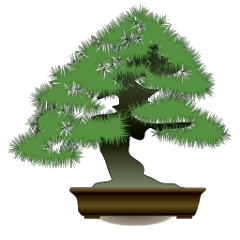March is the month of the first warmth and the plants begin to sprout. It is an exceptional month, all the plants resume their vegetative phase and now they need more sun and only in case of late frost will we return to protect them. For the bonsaist the most intense period begins. It is necessary to observe the enlargement of the buds: it is the first sign of the vegetative awakening. It is a good time to prune and repot. You can prune flower or fruit bonsai, saving the buds you want to make bloom.
WATERING
Watering must increase in frequency and should always be done during the hottest hours of the day, taking care to avoid excesses. If some fruit trees have already bloomed, the soil will need to be kept constantly moist. Even indoor bonsai will require more water. Don’t overdo the Pines otherwise the size of the needles will increase considerably.
PRUNING AND WIRING
Avoid pruning Beech, Oak, Hornbeam and Chestnut trees in this period (the operation had to be done last autumn): a shortened branch now runs the risk of being “forgotten” from the plant and dry when the other branches begin to vegetate.
FERTILIZATION
If Bonsai should not be repotted during the year, you can begin to fertilize it; otherwise, wait 30 to 45 days before fertilizing, to give the tree time to create new roots. Do not fertilize fruit plants if you want to reap the benefits.
PHYTOSANITARY TREATMENTS
Pesticide prevention plan must be strengthened by the onset of diseases. In addition to the use of a general acaricidal insecticide, a systemic fungicide can also be combined against rot. Preventive treatment against red spider on Apple trees, Pear trees, Cherry trees, Elms is recommended.
OTHER WORKS
The main works of this period are spinning and transplanting bonsai. As soon as we see the swollen buds, we will do the repotting by changing the soil (always very draining and not compact). The repotted tree will be protected from the last seasonal storms and from winds that could compromise its stability and rooting. For fruit trees we have to wait until after flowering. When the Pine candles begin to lengthen, we will be sure of being able to transplant them. After repotting, to help the plant we can administer, in the ways and dosages recommended on the packages, some vitamin complexes and stimulants to promote rooting.


